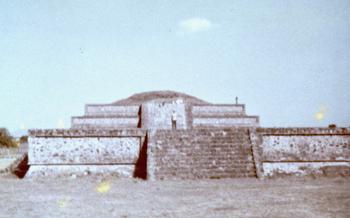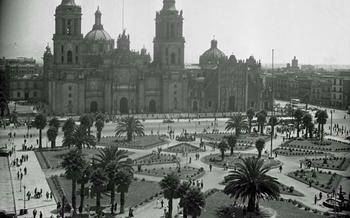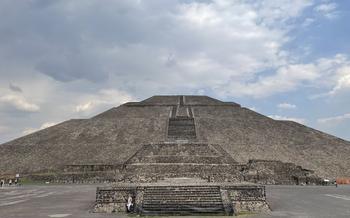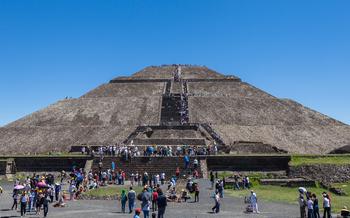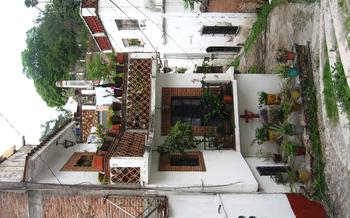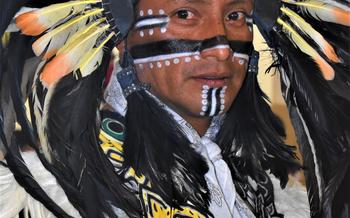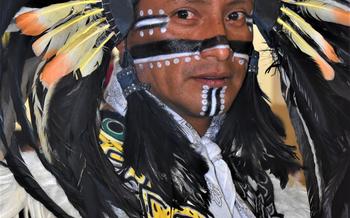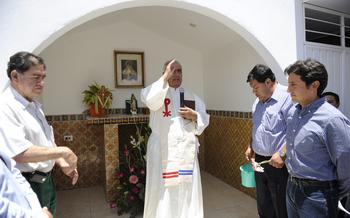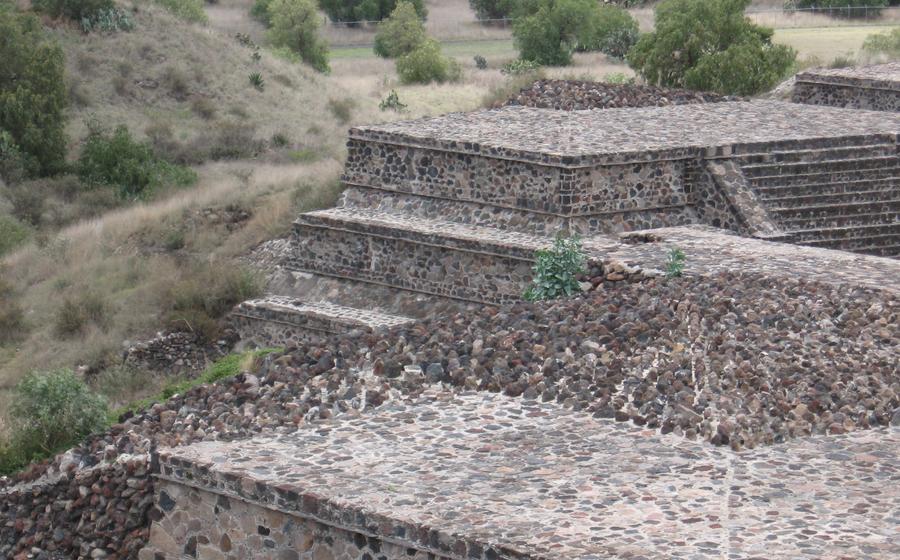
Acolman Monastery and Museum
- History of the Acolman Monastery
- Architectural Features
- The Church of San Agustín
- The Museum of the Acolman Monastery
- The Restoration of the Monastery
- Events and Activities
- Tips for Visitors
- Getting There
- Admission and Fees:
- Hours of Operation:
- Accessibility
- Surrounding Area:
- Insider Tip
History of the Acolman Monastery
Founded in 1527 by the Franciscan friar Martín de Valencia, the Acolman Monastery played a pivotal role in the evangelization of central Mexico. Initially intended as a school for the education of indigenous nobles, the monastery soon became a significant religious and cultural center. Its strategic location on the trade route between Mexico City and Veracruz further contributed to its importance. Over the centuries, the monastery underwent several renovations and expansions, reflecting the changing needs and influences of the time. Today, it stands as a testament to the rich history and cultural heritage of Mexico.
Architectural Features
The Acolman Monastery showcases a remarkable blend of architectural styles, reflecting the transition from Gothic to Renaissance during the colonial period in Mexico. Its design emphasizes simplicity and functionality, as seen in the use of clean lines, vaulted ceilings, and sturdy buttresses. The monastery's open chapel, a unique feature, allows for a seamless connection between the interior and exterior spaces, creating a sense of harmony with the surrounding landscape.
The impressive bell tower, rising majestically above the monastery, serves as a beacon for visitors. Its intricate carvings and decorative elements add a touch of elegance to the overall structure. The cloisters, with their serene arcades and lush gardens, provide a contemplative space for reflection and meditation.
The construction of the monastery utilized local materials and techniques, showcasing the skill and craftsmanship of indigenous artisans. The use of adobe bricks, volcanic stone, and wood beams reflects the region's rich natural resources and construction traditions. The monastery's design not only serves its religious purpose but also embodies the cultural and historical significance of this unique period in Mexican history.
The Church of San Agustín
The Church of San Agustín, the centerpiece of the Acolman Monastery, exudes grandeur and spiritual significance. Its interior is a testament to the artistic prowess and religious devotion of the Augustinian friars. The elaborate altarpiece, carved from a single piece of stone, depicts scenes from the life of St. Augustine, the patron saint of the church. The intricately carved choir stalls, featuring intricate designs and biblical figures, add to the church's solemn atmosphere.
The walls of the church are adorned with stunning murals, painted by indigenous artists under the guidance of Spanish friars. These murals depict biblical narratives, the lives of saints, and the history of the Augustinian order. The vibrant colors and expressive figures bring the stories to life, creating a captivating visual feast for visitors.
The Church of San Agustín served as the spiritual heart of the monastery, where the monks gathered for daily prayers, masses, and religious ceremonies. Its sacred ambiance and awe-inspiring artwork continue to inspire and captivate visitors, making it a must-see destination for anyone interested in Mexican colonial art and religious history.
Recent restoration efforts have meticulously preserved the church's original beauty and historical integrity. Visitors can now admire the restored murals, altarpiece, and choir stalls in their full glory, gaining a deeper appreciation for the artistic and spiritual heritage of the Acolman Monastery.
The Museum of the Acolman Monastery
The Museum of the Acolman Monastery, housed within the monastery's historic walls, offers visitors a glimpse into the rich cultural and religious heritage of the region. Its collection spans from pre-Hispanic artifacts to colonial-era paintings and religious relics, providing a comprehensive narrative of the area's past.
Notable exhibits include intricately carved stone sculptures from ancient Mesoamerican civilizations, such as the Olmecs and Aztecs. These artifacts offer a glimpse into the region's pre-Columbian roots and showcase the artistic prowess of its indigenous peoples.
The museum also houses a collection of colonial-era paintings, including works by renowned Mexican artists such as Miguel Cabrera and José de Ibarra. These paintings depict religious scenes, biblical figures, and historical events, offering insight into the artistic and cultural influences that shaped the region during the colonial period.
Among the religious relics on display are beautifully preserved vestments, intricately crafted gold and silver chalices, and delicately carved wooden sculptures. These objects, once used in religious ceremonies and rituals, provide a tangible connection to the monastery's rich spiritual history.
The museum's collection is not merely a display of artifacts; it is a testament to the cultural and religious tapestry that has woven together the history of the Acolman Monastery. Through its exhibits, the museum invites visitors to explore the region's deep-rooted traditions and gain a deeper understanding of its enduring significance.
The Restoration of the Monastery
The Acolman Monastery has undergone extensive restoration work in recent years, bringing new life to this architectural gem. The restoration process has been a delicate balance between preserving the original materials and techniques while incorporating modern conservation methods. Experts from various fields, including architects, historians, and conservators, have collaborated to ensure the authenticity and integrity of the restoration.
One of the main challenges faced during the restoration was the preservation of the original frescos and murals that adorn the monastery's walls. Specialized techniques were employed to clean and restore these delicate artworks, ensuring they remain vibrant and true to their original form.
The restoration of the monastery has not only preserved its historical and cultural significance but has also revitalized it as a vibrant center for cultural activities. Today, the monastery stands as a testament to the enduring legacy of Mexican architecture and its ongoing role in preserving the nation's rich cultural heritage.
Events and Activities
Throughout the year, the Acolman Monastery hosts a variety of special events and activities that showcase its cultural significance and vibrant atmosphere. One of the most popular annual events is the Festival de la Virgen de la Concepción, held in early December. This festival celebrates the patron saint of the monastery with colorful processions, traditional music and dance performances, and a lively fair with local crafts and culinary delights.
During Holy Week, the monastery becomes a center of religious devotion, hosting special masses, processions, and reenactments of the Passion of Christ. These events attract thousands of pilgrims and visitors who come to witness the solemn ceremonies and experience the spiritual atmosphere of the monastery.
Throughout the year, the monastery also organizes cultural events such as concerts, workshops, and exhibitions. These events provide a platform for local artists, musicians, and performers to showcase their talents and share their cultural heritage with the community. Visitors can attend these events to gain a deeper understanding of Mexican culture and traditions, while also enjoying the beautiful surroundings of the monastery.
Tips for Visitors
To fully appreciate the beauty and significance of the Acolman Monastery, here are some helpful tips for visitors:
-
Plan Your Visit: Choose a time of day when the monastery is less crowded, such as early morning or late afternoon. This will allow you to explore the grounds and admire the architecture without distractions.
-
Dress Comfortably: Wear comfortable clothing and sturdy shoes suitable for walking, as you will be doing a lot of exploring. The monastery's grounds are extensive, and you'll want to be able to move around freely.
-
Take Your Time: Don't rush your visit. Take the time to explore the different areas of the monastery, including the church, the museum, the courtyard, and the gardens. Each space has its own unique charm and history to discover.
-
Bring Your Camera: The Acolman Monastery is a photographer's paradise. Don't forget to bring your camera to capture the stunning architecture, the lush gardens, and the serene atmosphere of the place.
-
Ask Questions: If you have any questions or need assistance, don't hesitate to ask the staff at the monastery. They are knowledgeable and friendly and will be happy to help you make the most of your visit.
Getting There
To reach the Acolman Monastery from Mexico City, you can take the metro to the Indios Verdes station and then board a bus bound for Teotihuacan. The bus will drop you off right at the entrance to the monastery. Alternatively, you can take a guided tour from Mexico City that includes a visit to the monastery. These tours typically depart from the city center and provide transportation to and from the monastery. If you're driving yourself, take the Mexico-Pirámides highway and follow the signs to Teotihuacan. The monastery is located just off the highway, about 10 minutes from the pyramids. Ample parking is available on-site.
Admission and Fees:
Admission to the Acolman Monastery and Museum is typically charged, with fees varying depending on the type of ticket purchased. Regular admission tickets for adults usually range from 50 to 100 pesos (approximately 5 to 5 US dollars). There are often discounted rates for students, seniors, and children, as well as group discounts for larger parties. Guided tours, which provide a more in-depth exploration of the monastery's history and architecture, are available at an additional cost. These tours are highly recommended for those who want to learn more about the site's significance and gain a deeper understanding of its cultural and historical value. Visitors can purchase tickets at the monastery's entrance or online through authorized ticketing platforms. It's always a good idea to check the monastery's official website for the most up-to-date information on admission fees and any special promotions or events.
Hours of Operation:
The Acolman Monastery and Museum are open to the public from Tuesday to Sunday, with varying hours depending on the season. During the summer months (June to September), the monastery is open from 9:00 AM to 6:00 PM, while in the winter months (October to May), the hours are from 9:00 AM to 5:00 PM. On Mondays, both the monastery and the museum are closed.
To avoid crowds and ensure a more enjoyable experience, it is recommended to visit the monastery early in the morning or late in the afternoon. The monastery is also a popular destination for day trips from Mexico City, so it's best to plan your visit accordingly.
If you're planning to visit the monastery as part of a guided tour, it's essential to check the tour operator's schedule for specific hours of operation and availability. Guided tours typically last around two hours and provide visitors with a deeper insight into the history, architecture, and significance of the monastery.
Accessibility
The Acolman Monastery is committed to providing an accessible and inclusive environment for all visitors. The monastery features several accessibility features to ensure that everyone can enjoy its historical and cultural treasures. Wheelchair users and visitors with limited mobility can easily navigate the grounds and buildings with the help of ramps and elevators. Designated parking spaces are available for visitors with disabilities, located conveniently near the entrances. Additionally, the monastery provides assistive listening devices and sign language interpreters for visitors with hearing or visual impairments. Visitors with specific accessibility needs are encouraged to contact the monastery's staff in advance to ensure a seamless and enjoyable visit.
Surrounding Area:
The Acolman Monastery is situated in a region rich in history and natural beauty. Visitors can explore the nearby town of Teotihuacan, home to the awe-inspiring ancient pyramids of the Sun and Moon. The archaeological zone offers a glimpse into the fascinating culture and civilization that thrived in this region centuries ago. For those seeking outdoor adventures, the Sierra de Guadalupe National Park, with its rugged landscapes and hiking trails, is just a short drive away. The park offers breathtaking views of the surrounding mountains and valleys, making it a perfect spot for nature enthusiasts. To savor the authentic flavors of Mexican cuisine, visitors can head to the nearby town of San Juan Teotihuacan, where they can indulge in delicious traditional dishes and local specialties at the local markets and restaurants.
Insider Tip
For an unforgettable experience, visit the monastery during the annual Festival of San Agustín, held on August 28th. Immerse yourself in the vibrant atmosphere as locals and pilgrims gather to celebrate the patron saint of the monastery. Witness traditional dances, music, and processions that bring the courtyard and gardens to life. Don't miss the opportunity to sample delicious regional cuisine and handicrafts at the lively market stalls that line the monastery's grounds.
